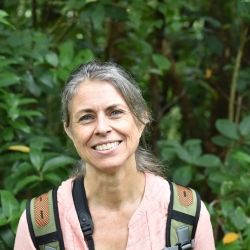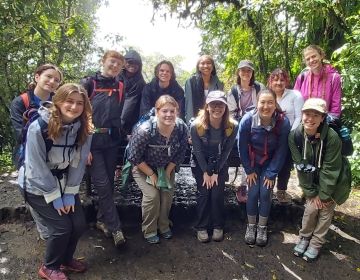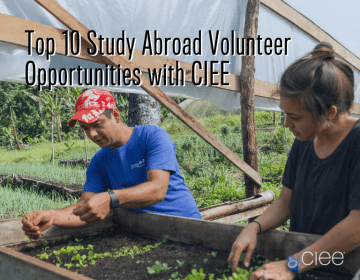Gallinero Para Gallinas Felices, by Shawn Clayton (CIEE Intern in Conservation and Sustainability; Oregon State University)
Gallinero Para Gallinas Felices
Our increasing population is demanding more food to avoid severe food insecurity. For developed
This is the day that the lovely chicks joined the CIEE family. In the back, you can see the empty space where the chicken coop will be built.and developing countries, food has become a commodity, leaving those who cannot afford it hungry or malnourished. Those faced with food insecurity can be helped if our society converts to our traditional ways of self-sufficiency. By producing and harvesting our own food we’ll lessen our dependence on the food industry, which can serve to better assist those malnourished. My internship with CIEE aims to promote home gardens and animal keeping by building a chicken coop in the heritage garden of the school. CIEE Monteverde, Costa Rica is a study abroad program that teaches and models sustainability to their students, the local communities, and tourists. The goal of my internship is to design and build a chicken coop with sustainable materials and ideas, along with a bilingual manual for chicken coop maintenance and hen rearing.
Ermida Porras is a local chicken owner showing me what and how she feeds her chickens.
Ownership of happy hens provides eggs and meat, so it was important to construct a chicken coop that is not only sustainable, but also safe and comfortable for the hens. To fulfill the sustainable aspect I designed the coop to be made out of some re-used wood but mostly bamboo, which is an invasive species in Monteverde. Everything from the foundation, the walls, and to the doors and their hinges are made out of bamboo. To provide safety for the chickens, I designed a modern version of a chicken coop, which entails an indoor coop with an attached outdoor run that is closed off with wire fencing. Most chicken coops, especially in Monteverde, do not include a secure coop or run because of the cost that goes into creating such security. However, my construction of a sustainable and safe chicken coop will stand as a model for an affordable, environmentally friendly, and effective way to manage hens.
I chose this project because it is a strong desire of mine to live self-sufficiently by having my own garden, chickens, beehive, cows, goats, and as many other animals that I can manage. I aspire to be self-sufficient for my own personal fulfillment, but this internship has now widened my outlook to the global importance of self-sufficiency in regards to human welfare, economy, and the environment. While comprehending a great deal more of its significance, I also have learned new information and skills to fulfill my desire of having my own chicken coop. I have researched and interviewed local chicken owners about maintaining chickens, designed a coop based on the information and regulations I was given, written a manual to inform future students and staff on hen maintenance, and built the coop that will soon house the three little chicks that have recently joined the CIEE family. Even though designing and constructing the coop is a huge accomplishment for myself since I have never accomplished such a task, my greatest accomplishment in the internship is not only setting a model of sustainable living for myself, but for others in the society of Monteverde.
I’m laying on top of the newly built floor of the coop to show off its support and size.
Related Posts
Costa Rica vs. Argentina: Which is Better for Study Abroad?
Imagine yourself sipping mate in a bustling Buenos Aires café or lounging peacefully in a hammock overlooking Costa Rica's lush rainforests. These contrasting scenes represent just a glimpse of the... keep reading
Happy Earth Day: Today and Every Day
Happy Earth Day! Every April 22, this global event comes around to remind us how precious our planet is, what sustainable efforts we can make to protect Earth, and that... keep reading
Top 10 Study Abroad Volunteer Opportunities with CIEE
Have you ever wondered if you could volunteer abroad? Perhaps you're looking into study abroad programs that provide international volunteer opportunities. If you’re itching to study abroad and truly make... keep reading



